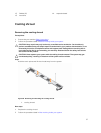
Installing the cooling shroud
Prerequisites
• Ensure that you read the Safety instructions.
CAUTION: Many repairs may only be done by a certified service technician. You should only
perform troubleshooting and simple repairs as authorized in your product documentation, or as
directed by the online or telephone service and support team. Damage due to servicing that is
not authorized by Dell is not covered by your warranty. Read and follow the safety instructions
that came with the product.
NOTE: For proper seating of the cooling shroud in the chassis, ensure that the cables inside the
system are routed along the chassis wall and secured using the cable securing bracket.
Steps
1. Align the tabs on the cooling shroud with the securing slots on the chassis.
2. Lower the cooling shroud into the chassis until it is firmly seated.
Next steps
Follow the procedure listed in After working inside your system.
System memory
Your system supports DDR4 registered DIMMs (RDIMMs), and load reduced DIMMs (LRDIMMs).
NOTE: MT/s indicates DIMM speed in MegaTransfers per second.
Memory bus operating frequency can be 1333 MT/s, 1600 MT/s, 1866 MT/s, or 2133 MT/s depending on
the following factors:
• DIMM type (RDIMM or LRDIMM)
• Number of DIMMs populated per channel
• System profile selected (for example, Performance Optimized, Custom, or Dense Configuration
Optimized)
• Maximum supported DIMM frequency of the processors
The system contains 24 memory sockets split into two sets of 12 sockets, one set per processor. Each 12-
socket set is organized into four channels. In each channel, the release levers of the first socket are
marked white, the second socket black, and the third socket green.
NOTE: DIMMs in sockets A1 to A12 are assigned to processor 1 and DIMMs in sockets B1 to B12 are
assigned to processor 2.
58


















